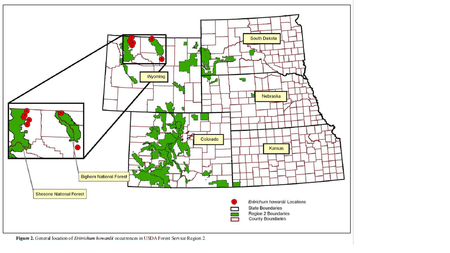Eritrichium howardii
| Eritrichium howardii | |
|---|---|
| Scientific classification | |
| Kingdom: | Plantae |
| (unranked): | Angiosperms |
| (unranked): | Eudicots |
| (unranked): | Asterids |
| Order: | Boraginales |
| Family: | Boraginaceae |
| Genus: | Eritrichium |
| Species: | E. howardii |
| Binomial name | |
| Eritrichium howardii (A. Gray) Rydb. | |
The Howard’s alpine forget-me-not, (Eritrichium howardii), is a rare flowering plant found in the Rocky Mountain area most notably in Wyoming and Montana. It is a pleasant light blue to purplish flower that has a yellow ring around the middle. It has 5 petals
Distribution
Eritrichium howardii exists in the Rocky Mountain area. However it is not a well studied species and most information about its distribution comes from informal sightings and not carefully carried out surveys. The Eritrichium genus exists in Eurasia widely however only three species are found in North America and howardii is one of those species.[1] Eritrichum howardii’s range is included within the Yellowstone Highlands and Bighorn Mountains sections of the Southern Rocky Mountain Steppe Open Woodland, Coniferous Forest Alpine Meadow Province.[2]

Habitat and Ecology
Eritrichum howardii is a cushion-like, matforming species that tends to occur in more or less open, sparsely vegetated sites with little shade, most often on calcareous soils. .[3] According to the species documented in Montana the flowers were found occurrences on open, exposed ridges or grassy slopes, sometimes associated with Pinus flexilis (limber pine. Howardii was observed in different types of soil including deep red clay, dolomite, and limestone. Elevations were seen to range from 1,219 to 2,651 m.[4]
Morphology
Eritrichum howardii is a densely matted, longlived perennial herb under 10 cm tall. The plant often appears stemless. The leaves are densely silvery-hairy and narrowly oblanceolate with acute tips. The flowers are bright blue and showy (5 to 9 mm wide), with a yellow center or eye. The flowers are borne in dense clusters at the tip of the stems. The fruit consists of one to four hairy nutlets.[4][5][6]
Management
The environment described in the Wyoming survey that was done indicates that this plant is most likely quite stress tolerant. It occurs in windswept areas in rough gravely substrate.[1] Potential specific risks that this plant faces are not well understood but due to the environment the USDA assumes that some risks may be ORV recreation, road development, impacts of hikers and pack animals, grazing, and fire. Other potential threats to the species include air pollution (i.e., acid rain, nitrogen deposition), extreme weather conditions, and global warming. Eritrichum howardii may also be subject to genetic risk due to the small size and isolated nature of occurrences. Small populations of rare plants may be subject to the deleterious affects of inbreeding or the founder effect.[1] At this time however it does not seem that reliable data on population trends exists for this species and there needs to be more study done on this species and others that exist in this particular climate.
References
- 1 2 3 { Lynn Moore and Sandy Friedley |2006| Eritrichum howardii (Gray) Rydberg(Howard’s alpine forget-me-not)A Technical Conservation Assessment pages 2–35}
- ↑ {McNab, W.H. and P.E. Avers. 1994. Ecological subregions of the United States: section descriptions. Administrative Publication WO-WSA-5. Washington, D.C. 267 pp.}
- ↑ {Lynn Moore and Sandy Friedley|year=2006|title= Eritrichum howardii (Gray) Rydberg(Howard’s alpine forget-me-not)A Technical Conservation Assessment= pages=2–35}
- 1 2 {Fertig, W. 2000. State species abstract for Eritrichum howardii. Wyoming Natural Diversity Database. Available online at http://uwyo.edu/wyndd}
- ↑ Hitchcock, C.L., A. Cronquist, M. Ownbey, and J.W. Thompson. 1959. Vascular plants of the Pacific northwest. The New York Botanical Garden, Bronx, NY.
- ↑ {Dorn, R.D. 1992. Vascular plants of Wyoming. Second edition. Mountain West Publishing, Cheyenne, WY}